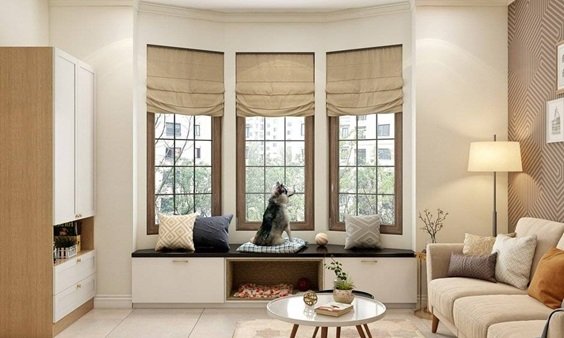
When it comes to achieving a good night’s sleep, the art of interior design plays a pivotal role. It’s not just about the number of hours you spend in bed; it’s about the quality of those hours. For interior design enthusiasts and health-conscious individuals alike, creating a sleep setup that promotes restful slumber is a dream worth pursuing. In this blog post, we will explore tips and tricks to help you design a sleep sanctuary that enhances your well-being and rejuvenates your spirit.
The Importance of a Sleep-Inducing Environment
Your bedroom should be more than just a place to crash at the end of the day. It should be a sanctuary that promotes relaxation and rest. Achieving this requires careful consideration of various elements that contribute to a sleep-inducing environment.
Lighting, for instance, plays a crucial role in setting the mood for sleep. Opt for soft, warm lighting that mimics the natural transition from day to night. Avoid harsh overhead lights that can disrupt your body’s internal clock. Instead, consider bedside lamps with dimmer switches to create a cozy ambiance.
Another key factor is color. The color palette of your bedroom can significantly impact your mood and sleep quality. Soft, muted colors like pastel blues, greens, and lavenders are known for their calming effects. These hues can create a serene atmosphere that encourages relaxation and restfulness.
Choosing the Right Mattress for Comfort
Your mattress is the foundation of your sleep setup, and choosing the right one can make all the difference in your quality of rest. With so many options available, it can be overwhelming to find the perfect fit for your needs.
When selecting a mattress, consider factors such as firmness, material, and size. Firmness is subjective and varies from person to person, so it’s essential to try different options to find what feels most comfortable to you. Memory foam, latex, and hybrid mattresses offer varying levels of support and comfort.
If you find yourself waking up with aches and pains, it might be time to invest in a new mattress. For those in Salt Lake City, finding a reputable nectar mattress dealer can be a game-changer, offering expert advice and top-quality options to ensure a restful night’s sleep.
The Role of Bedding in Sleep Quality
Bedding is more than just a decorative element; it plays a significant role in your sleep quality. The right sheets, blankets, and pillows can enhance your comfort and contribute to a peaceful night’s rest.
When choosing bedding, prioritize materials that promote breathability and temperature regulation. Natural fibers like cotton and linen are excellent choices, as they wick away moisture and help maintain a comfortable sleeping temperature. Additionally, invest in a quality pillow that provides the right level of support for your neck and spine.
Don’t forget about the aesthetics. Coordinating bedding with your overall bedroom design can create a cohesive and inviting atmosphere. From soft, muted tones to bold patterns, your bedding should reflect your personal style while promoting relaxation.
Creating a Calming Bedtime Routine
A calming bedtime routine is essential for preparing your mind and body for sleep. Establishing a consistent routine signals to your brain that it’s time to wind down and relax.
Start by setting a regular bedtime and wake-up time, even on weekends. Consistency helps regulate your body’s internal clock, making it easier to fall asleep and wake up naturally. Incorporate relaxing activities into your routine, such as reading a book, taking a warm bath, or practicing meditation.
Digital devices can disrupt your sleep, so it’s a good idea to power down screens at least an hour before bedtime. The blue light emitted by screens interferes with melatonin production, the hormone responsible for regulating sleep. Instead, opt for screen-free activities that promote relaxation and mindfulness.
Designing a Peaceful Sleep Space
The layout and organization of your bedroom can significantly impact your sleep quality. A cluttered and chaotic space can create stress and anxiety, making it difficult to unwind.
Start by decluttering your bedroom and removing any unnecessary items. A minimalist approach can create a sense of calm and order, allowing you to focus on relaxation. Consider investing in storage solutions to keep your space tidy and organized.
The placement of furniture also matters. Position your bed against a solid wall, away from windows and doors, to create a feeling of security and stability. Add soft rugs and curtains to absorb sound and create a quieter environment conducive to sleep.
Incorporating Nature for a Restful Retreat
Bringing elements of nature into your bedroom can enhance your sleep environment and promote relaxation. Natural elements like plants, wood, and stone can create a soothing and grounding atmosphere.
Indoor plants not only add a touch of greenery but also purify the air and improve indoor air quality. Consider low-maintenance options like snake plants, peace lilies, or pothos that thrive in low-light conditions. The presence of plants can create a calming ambiance and promote a sense of tranquility.
Natural materials like wood and stone can add warmth and texture to your space. Incorporate these elements through furniture, decor, or even a feature wall. The organic beauty of natural materials can create a serene and inviting atmosphere that enhances your sleep experience.
Conclusion
Creating the perfect sleep setup is an art that combines interior design with health-conscious choices. By paying attention to lighting, color, mattress selection, bedding, and overall bedroom design, you can transform your sleep space into a sanctuary that promotes relaxation and rejuvenation.
Remember, a restful night’s sleep is essential for your overall well-being. By implementing these tips and tricks, you can enhance your sleep quality and wake up refreshed and ready to take on the day. For further inspiration and guidance, consider consulting with interior design experts or sleep specialists who can help you create the bedroom of your dreams.





